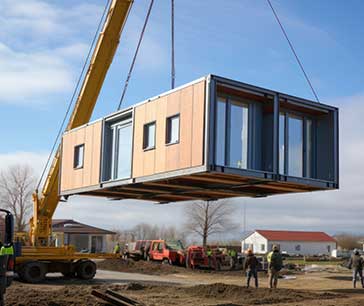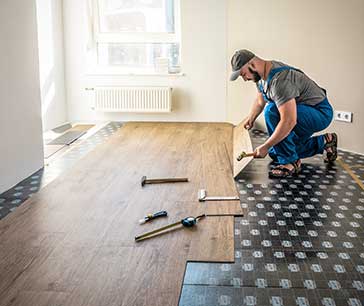Table Of Contents

Sonia Mutreja

Pooja Parvatkar
Top 10 Markets in the Construction Sector that Ruled 2023

In 2023, the construction sector witnessed a surge in sustainable practices, with increased use of eco-friendly materials and energy-efficient technologies. Advanced robotics and 3D printing gained prominence, enhancing construction speed and precision. Smart construction sites with IoT integration improved safety and productivity, marking a transformative year for the industry. Allied Market Research has collated the top 10 markets to have seen exponential growth and opportunities in 2023 and hold a bright future in 2024.
Modular Construction
Rapid urbanization and population growth have increased the demand for affordable and efficient construction solutions, prompting the adoption of modular methods. Time and cost efficiencies play a pivotal role as modular construction allows for simultaneous site preparation and module fabrication. Sustainability concerns have also been driving the market, with modular construction often leading to reduced material waste and energy consumption. Additionally, advancements in technology, such as Building Information Modeling (BIM) and 3D printing, have enhanced the precision and customization capabilities of modular construction, further fueling its popularity in the global construction industry. The global modular construction market is projected to reach $234.7 billion by 2031, growing at a CAGR of 6.1% from 2022 to 2031.

Windows and Doors
Rising construction activities, especially in the residential sector, driven by urbanization and population expansion, have contributed significantly to the demand for windows and doors. Increasing awareness about energy efficiency and sustainability fostered a growing market for energy-efficient windows and doors. Additionally, stringent building regulations pertaining to safety and energy standards have globally fostered growth in the market. Aesthetic considerations and evolving architectural trends have also contributed to the demand for innovative and stylish windows and doors, further influencing market dynamics. The global windows and doors market is anticipated to reach $356.7 billion by 2032, growing at a CAGR of 5.5% from 2023 to 2032.
Prefabricated Homes
The speed of construction, cost-effectiveness, and reduced waste associated with prefabricated homes appeal to a market seeking quick and sustainable housing solutions. Technological advancements, including improved design and manufacturing processes, enhance the quality and customization options of prefabricated homes, attracting a broader consumer base. Environmental concerns and a growing emphasis on sustainable practices contribute to the popularity of prefab homes, aligning with eco-friendly building trends. Government initiatives promoting affordable and green housing also play a crucial role in propelling the prefabricated homes market. The global prefabricated homes market is predicted to reach $38.9 billion by 2032, growing at a CAGR of 6.7% from 2023 to 2032.
Construction Flooring
The surge in construction activities, both residential and commercial, contributes significantly to the demand for diverse flooring solutions. Technological innovations, such as the development of sustainable and resilient flooring materials, propel market expansion. The increasing focus on green building practices and LEED certification requirements enhances the adoption of eco-friendly flooring options. Aesthetic considerations and evolving design trends influence consumer choices, driving the market for innovative and visually appealing flooring solutions. Additionally, the demand for low-maintenance and durable flooring in high-traffic areas fuels the growth of the construction flooring market, aligning with the evolving needs of the construction industry. The global construction flooring market is anticipated to garner $189.3 billion by 2032, growing at a CAGR of 5.3% from 2023 to 2032.

Natural Stone
Architectural and design preferences fuel demand for natural stone in residential and commercial construction. The durability, aesthetic appeal, and versatility of natural stone make it a sought-after choice for flooring, countertops, and cladding. Rising disposable incomes and an emphasis on luxury interiors contribute to the market expansion. Additionally, sustainability trends drive the popularity of natural stone, given its longevity and recyclability. Infrastructure development projects globally, including landscaping and public spaces, further boost the demand. Technological advancements in quarrying and processing also enhance the efficiency and accessibility of natural stone, consolidating its position in the construction materials market. The global natural stone market is projected to reach $57.6 billion by 2032, growing at a CAGR of 4.4% from 2023 to 2032.
Glass Curtain Wall
Modern architectural trends emphasizing aesthetics, energy efficiency, and natural light penetration drive the demand for glass curtain walls in commercial and residential construction. Sustainable building practices and green certifications contribute to the popularity of energy-efficient glass systems. Technological advancements, such as high-performance coatings and smart glass solutions, enhance the functionality of curtain walls. Additionally, the lightweight nature of glass curtain walls reduces the overall building weight and construction costs. Urbanization and a growing focus on contemporary design further stimulate market expansion as glass curtain walls offer a seamless blend of functionality and visual appeal in modern structures. The global glass curtain wall market is analyzed to reach $99.5 billion by 2032, growing at a CAGR of 6.8% from 2023 to 2032.
Construction Aggregates
Urbanization and infrastructure development globally fuel the demand for construction aggregates, including crushed stone, sand, and gravel. These materials serve as essential components in concrete and asphalt production, supporting the construction industry's growth. Increasing investments in residential, commercial, and public infrastructure projects contribute to the market's expansion. The ongoing trend of urbanization and modernization underscores the crucial role of construction aggregates in meeting the escalating infrastructure demands. The global construction aggregates market is anticipated to reach $667.8 billion by 2032, growing at a CAGR of 5.2% from 2023 to 2032.
Green Steel
Growing environmental concerns and the imperative to reduce carbon emissions have propelled the demand for green steel, produced through innovative methods like hydrogen-based processes. Stringent government regulations and corporate sustainability goals incentivize the adoption of low-carbon steel production techniques, favoring the market's growth. Increased consumer awareness and preferences for environmentally responsible products further drive the shift towards green steel. Technological advancements in metallurgy and the scaling up of green steel production capacities contribute to the market's expansion, marking a pivotal transition in the steel industry towards more sustainable practices. The global green steel market is projected to reach $364.5 billion by 2032, growing at a CAGR of 113.6% from 2023 to 2032.
Kitchen Countertop
Increasing consumer focus on kitchen aesthetics and design, coupled with the rising trend of home renovations, propels the demand for innovative and stylish countertops. Functional considerations, such as durability and ease of maintenance, contribute to the popularity of materials like granite, quartz, and marble. Advancements in manufacturing technologies and a wide range of design options further fuel market growth. Additionally, the expanding residential construction sector globally and the growing popularity of open-plan kitchen layouts stimulate the demand for high-quality kitchen countertops, making it a dynamic and evolving market. The global kitchen countertop market is analyzed to reach $80.4 billion by 2032, growing at a CAGR of 3.9% from 2023 to 2032. The report generated the highest leads in 2023.

Concrete Repair Mortar
Aging infrastructure, particularly in developed regions, necessitates maintenance and repair, boosting the demand for effective concrete repair solutions. The construction industry's focus on extending the lifespan of structures and ensuring safety drives the adoption of high-performance repair mortars. Additionally, stringent regulations and standards pertaining to structural integrity and safety contribute to market growth. Technological advancements in the formulation of repair mortars enhance durability and application efficiency, further stimulating market demand. The increasing volume of construction activities globally, along with a growing awareness of sustainable and long-lasting repair solutions, further fuels the expansion of the concrete repair mortar market. The global concrete repair mortar market is projected to reach $5.3 billion by 2032, growing at a CAGR of 5.6% from 2023 to 2032.
AMR Verdict
In 2023, the construction sector experienced robust growth globally. Technological advancements, including AI and automation, revolutionized project management and efficiency. Sustainable building practices gained prominence, driven by environmental concerns. Despite material cost fluctuations, increased demand for infrastructure projects and smart construction solutions fueled the industry's expansion, fostering innovation and resilience. The construction sector in 2024 is poised to continue its upward trajectory, marked by increased digitalization and modular construction adoption. Sustainability is anticipated to remain a key focus, with a surge in eco-friendly materials and practices. Global collaboration and resilient supply chains should mitigate challenges, driving the industry towards greater efficiency, innovation, and adaptability.
AMR provides a plethora of reports with historic, current, and future insights to help businesses navigate challenges seamlessly. AMR reports provide information on trends, growth prospects, key players, and other aspects for clients to make informed business decisions. The reports include an in-depth analysis of the competitive landscape within the construction sector. This helps clients in identifying key players, their market share, strategies, and product offerings and understanding the competitive environment which is essential for companies to position themselves effectively and gain a competitive edge. The reports include segmentation, regulatory landscape, Porter’s analysis, geographical analysis, among the various aspects covered. Get in touch to stay ahead of the competition.

